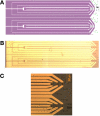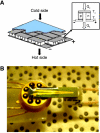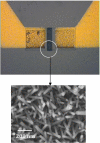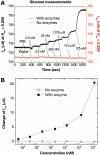Aluminum gallium nitride (GaN)/GaN high electron mobility transistor-based sensors for glucose detection in exhaled breath condensate
- PMID: 20167182
- PMCID: PMC2825639
- DOI: 10.1177/193229681000400122
Aluminum gallium nitride (GaN)/GaN high electron mobility transistor-based sensors for glucose detection in exhaled breath condensate
Abstract
Background: Immobilized aluminum gallium nitride (AlGaN)/GaN high electron mobility transistors (HEMTs) have shown great potential in the areas of pH, chloride ion, and glucose detection in exhaled breath condensate (EBC). HEMT sensors can be integrated into a wireless data transmission system that allows for remote monitoring. This technology offers the possibility of using AlGaN/GaN HEMTs for extended investigations of airway pathology of detecting glucose in EBC without the need for clinical visits.
Methods: HEMT structures, consisting of a 3-microm-thick undoped GaN buffer, 30-A-thick Al(0.3)Ga(0.7)N spacer, and 220-A-thick silicon-doped Al(0.3)Ga(0.7)N cap layer, were used for fabricating the HEMT sensors. The gate area of the pH, chloride ion, and glucose detection was immobilized with scandium oxide (Sc(2)O(3)), silver chloride (AgCl) thin film, and zinc oxide (ZnO) nanorods, respectively.
Results: The Sc(2)O(3)-gated sensor could detect the pH of solutions ranging from 3 to 10 with a resolution of approximately 0.1 pH. A chloride ion detection limit of 10(-8) M was achieved with a HEMT sensor immobilized with the AgCl thin film. The drain-source current of the ZnO nanorod-gated AlGaN/GaN HEMT sensor immobilized with glucose oxidase showed a rapid response of less than 5 seconds when the sensor was exposed to the target glucose in a buffer with a pH value of 7.4. The sensor could detect a wide range of concentrations from 0.5 nM to 125 microM.
Conclusion: There is great promise for using HEMT-based sensors to enhance the detection sensitivity for glucose detection in EBC. Depending on the immobilized material, HEMT-based sensors can be used for sensing different materials. These electronic detection approaches with rapid response and good repeatability show potential for the investigation of airway pathology. The devices can also be integrated into a wireless data transmission system for remote monitoring applications. This sensor technology could use the exhaled breath condensate to measure the glucose concentration for diabetic applications.
2010 Diabetes Technology Society.
Figures








Similar articles
-
Open-gated pH sensor fabricated on an undoped-AlGaN/GaN HEMT structure.Sensors (Basel). 2011;11(3):3067-77. doi: 10.3390/s110303067. Epub 2011 Mar 9. Sensors (Basel). 2011. PMID: 22163786 Free PMC article.
-
Potassium selective chemically modified field effect transistors based on AlGaN/GaN two-dimensional electron gas heterostructures.Biosens Bioelectron. 2007 Jun 15;22(12):2796-801. doi: 10.1016/j.bios.2006.10.010. Epub 2006 Nov 13. Biosens Bioelectron. 2007. PMID: 17098415
-
AlGaN/GaN High Electron Mobility Transistor-Based Biosensor for the Detection of C-Reactive Protein.Sensors (Basel). 2015 Jul 28;15(8):18416-26. doi: 10.3390/s150818416. Sensors (Basel). 2015. PMID: 26225981 Free PMC article.
-
Challenges and Opportunities for High-Power and High-Frequency AlGaN/GaN High-Electron-Mobility Transistor (HEMT) Applications: A Review.Micromachines (Basel). 2022 Dec 1;13(12):2133. doi: 10.3390/mi13122133. Micromachines (Basel). 2022. PMID: 36557432 Free PMC article. Review.
-
Electronic Biosensors Based on III-Nitride Semiconductors.Annu Rev Anal Chem (Palo Alto Calif). 2015;8:149-69. doi: 10.1146/annurev-anchem-071114-040247. Epub 2015 May 27. Annu Rev Anal Chem (Palo Alto Calif). 2015. PMID: 26048553 Review.
Cited by
-
Low-Power pH Sensor Based on Narrow Channel Open-Gated Al0.25Ga0.75N/GaN HEMT and Package Integrated Polydimethylsiloxane Microchannels.Materials (Basel). 2020 Nov 22;13(22):5282. doi: 10.3390/ma13225282. Materials (Basel). 2020. PMID: 33266399 Free PMC article.
-
Potential Applications of Rare Earth Metal Nanoparticles in Biomedicine.Pharmaceuticals (Basel). 2025 Jan 24;18(2):154. doi: 10.3390/ph18020154. Pharmaceuticals (Basel). 2025. PMID: 40005968 Free PMC article. Review.
-
Noninvasive glucose detection in exhaled breath condensate.Transl Res. 2019 Nov;213:1-22. doi: 10.1016/j.trsl.2019.05.006. Epub 2019 May 30. Transl Res. 2019. PMID: 31194942 Free PMC article. Review.
-
The Leakage Mechanism of the Package of the AlGaN/GaN Liquid Sensor.Materials (Basel). 2020 Apr 17;13(8):1903. doi: 10.3390/ma13081903. Materials (Basel). 2020. PMID: 32316694 Free PMC article.
-
Synthesis of gallium nitride nanostructures by nitridation of electrochemically deposited gallium oxide on silicon substrate.Nanoscale Res Lett. 2014 Dec 18;9(1):685. doi: 10.1186/1556-276X-9-685. eCollection 2014. Nanoscale Res Lett. 2014. PMID: 25593562 Free PMC article.
References
-
- Kullmann T, Barta I, Antus B, Valyon M, Horváth I. Environmental temperature and relative humidity influence exhaled breath condensate pH. Eur Respir J. 2008;31(2):474–475. - PubMed
-
- Horváth I, Hunt J, Barnes PJ, Alving K, Antczak A, Baraldi E, Becher G, van Beurden WJ, Corradi M, Dekhuijzen R, Dweik RA, Dwyer T, Effros R, Erzurum S, Gaston B, Gessner C, Greening A, Ho LP, Hohlfeld J, Jöbsis Q, Laskowski D, Loukides S, Marlin D, Montuschi P, Olin AC, Redington AE, Reinhold P, van Rensen EL, Rubinstein I, Silkoff P, Toren K, Vass G, Vogelberg C, Wirtz H ATS/ERS Task Force on Exhaled Breath Condensate. Exhaled breath condensate: methodological recommendations and unresolved questions. Eur Respir J. 2005;26(9):523–548. - PubMed
-
- Namjou K, Roller CB, McCann PJ. The Breathmeter–a new laser device to analyze your health. IEEE Circuits Devices Mag. 2006;22(5):22–28.
-
- Kullmann T, Barta I, Lázár Z, Szili B, Barát E, Valyon M, Kollai M, Horváth I. Exhaled breath condensate pH standardised for CO2 partial pressure. Eur Respir J. 2007;29(3):496–501. - PubMed
Publication types
MeSH terms
Substances
LinkOut - more resources
Full Text Sources
Miscellaneous

